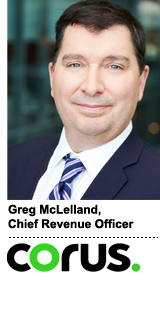 As one of Canada’s top three media companies, Corus Entertainment’s wide-ranging footprint spans TV and radio.
As one of Canada’s top three media companies, Corus Entertainment’s wide-ranging footprint spans TV and radio.
Navigating the data landscape is a tall order for any linear TV company, but Corus is placing bets on a future when data flows as freely in broadcast as it does in digital, despite tighter regulatory restrictions that exist in the Canadian market.
Following its $2.65 billion acquisition of wireless and cable provider Shaw Media this spring, Corus now manages 45 specialty and 15 conventional TV channels and 39 radio stations.
Shortly after the deal, Corus signed with Visible World, Comcast’s targeted TV platform, to build the basis of its programmatic TV stack.
Corus had already licensed an ad server and trafficking system, but it needed a seller platform that allowed demand-side platforms and trading desks to plug into its programmatic supply easily.
“When we talk about programmatic, we’re talking about taking our schedules, applying set-top box data and programmatically creating a whole schedule for advertisers across our 45 networks priced consistently, which they can’t do today,” said Greg McLelland, CRO for Corus. “This is where the power of programmatic will benefit us and the advertiser.”
Augmenting Addressability
Although the dynamics of programmatic supply and demand aren’t fully fleshed out in linear schedules, Corus is already augmenting set-top box data for addressable buys.
Corus extracts second-by-second set-top box data in a privacy-compliant manner from about 500,000 to 750,000 households in Canada.
Similar to Dish or Cablevision in the US, Corus would amalgamate viewership data at the postal-code level and then overlay data from Environics, which would be the equivalent of an Experian in the US.
“We would know how many people are in a household, their education and income level, as well as psychographic data,” McLelland said. “We can go back to advertisers and say, ‘If you’re looking for moms with three kids who live in a suburb with a minivan, here’s what they’re watching.’”
In this case, Corus could tell an advertiser which programs overindex on their desired audience.
Although it’s not addressable in the sense that two different ads are reaching two different households in the same commercial pod, a targeted ad would be served to the subset of households identified as a high-indexing audience cluster.
But Corus is also conducting household addressable trials in Ontario using Invidi to help auto advertisers segment their cable footprint and serve different commercials to different households in the same commercial pod.
Navigating The Waters Of Canadian Data
Although Canadian and US broadcasters all want more data-enabled buys, there are key differences between the two markets. Third-party data in Canada, for example, is not as robust as in the US.
While there are Canadian equivalents of big US shopper data offerings like Nielsen Catalina – such as Canadian drug store Shoppers Drug Mart, which provides anonymized loyalty card data via its Optimum rewards program – they are few and far between.
And compliance policies are more stringent.
“This is why we’re very, very hesitant to do anything below or more targeted than a ZIP postal code in Canada, which represents about 16 to 20 households,” McLelland added.
This contrasts with advertisers’ use of more granular data from third-party providers in the US, such as Polk.
For instance, if BMW queries Polk for Audi customers ending a lease in the next six months, McLelland claims Polk can more or less provide exact household matches for BMW to conquest those consumers with its own commercials.
Despite some of these data limitations, Canada may be slightly ahead of US broadcasters overall in enabling more linear inventory to be bought and sold programmatically because it only sells national inventory.
“We don’t have local avails in Canada where broadcasters have two-minute [pods] as their own revenue source,” he said. “We sell on the national level in prime time, which is slightly ahead of what’s happening in the US, as I understand it. It’s a much bigger deal up here.”














